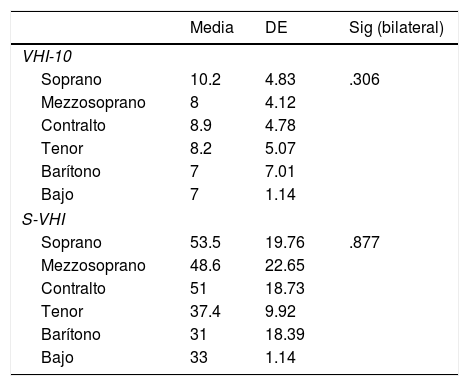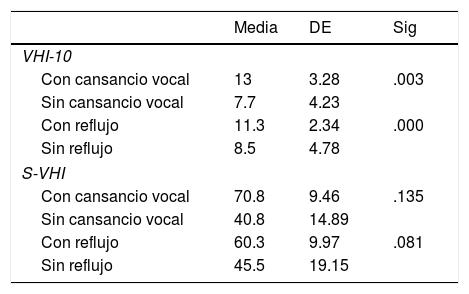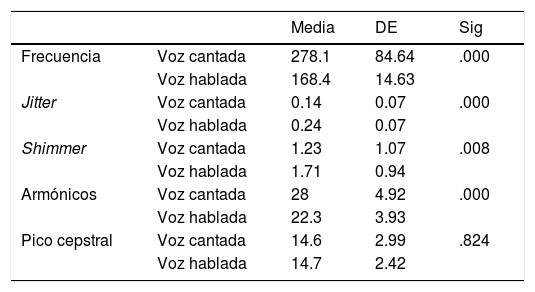Los cantantes son uno de los grupos de profesionales de la voz con mayor prevalencia de patología vocal y están expuestos a muchos factores de riesgo. Esto se acrecienta en el caso de los cantantes de coros amateurs que no suelen recibir nociones de técnica vocal.
MétodoSe estudiaron las características vocales y los factores de riesgo de 39 cantantes de coros amateur mediante el índice de incapacidad vocal abreviado (VHI-10), el índice de incapacidad vocal para el canto (S-VHI), laringoestroboscopia y análisis vocal.
ResultadosLos cantantes que no habían recibido clases de técnica vocal obtuvieron puntuaciones más altas tanto en el VHI-10 (10.5; p=.001) como en el S-VHI (55.9; p=.010) frente a los que sí (4 en el VHI-10 y 31.4 en el S-VHI). Respecto al sexo, encontramos que las mujeres alcanzan puntuaciones más altas (51.6) que los hombres (35) en el S-VHI (p=.019). En la muestra encontramos 9 sujetos (23.1%) con signos de fatiga vocal y 6 (15.4%) con reflujo. En el análisis acústico la frecuencia es más alta en la voz cantada (278.1HZ) que en la hablada (168.4Hz), los armónicos también son mayores en voz cantada (28dB) que en voz hablada (22dB), los valores de jitter son más altos en la voz hablada (0.24) que en la cantada (0.14) y los del shimmer también son más altos en la voz hablada (1.71) que en la cantada (1.23).
ConclusionesLa falta de nociones de técnica vocal en cantantes de coros amateur condiciona una mayor puntuación en los test VHI-10 y S-VHI, así como alteraciones en la laringe.
Singers are one of the groups of voice professionals with a higher incidence of vocal disorders which expose them to many risk factors. These risks are even higher in singers in amateur choirs, who usually lack vocal technique.
MethodVocal traits and risk factors of 39 amateur choir singers were studied using the VHI-10, the S-VHI, laryngeal examination and acoustic analysis.
ResultsThe singers who had not received lessons in vocal technique obtained higher marks in VHI-10 (10.5; P=.001) as well as in S-VHI (55.9; P=.010) compared to those who had (4 in VHI-10 and 31.4 in S-VHI). As regards sex, we find that women achieve higher marks (51.6) than men (35) in the S-VHI (P=.019). In the sample we find 9 subjects (23.1%) with evidence of vocal fatigue and 6 (15.4%) with reflux. In the acoustic analysis we observe that the frequency is higher in the singing voice (278.1HZ) than in the speaking voice (168.4Hz), the harmonics are also higher in the singing voice (28dB) than in the speaking voice (22dB), the jitter values are higher in the speaking voice (.24) than in the singing voice (.14), and shimmer values are also higher in the speaking voice (1.71) than in the singing voice (1.23).
ConclusionThe lack of vocal technique in amateur choir singers determines a higher mark in the VHI-10 and S-VHI tests together with alterations to the larynx.
Artículo
Comprando el artículo el PDF del mismo podrá ser descargado
Precio 19,34 €
Comprar ahora












